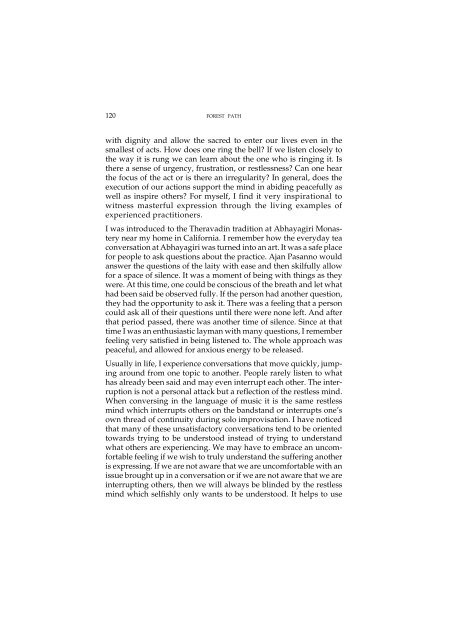Forest Path - Amaravati Buddhist Monastery
Forest Path - Amaravati Buddhist Monastery
Forest Path - Amaravati Buddhist Monastery
You also want an ePaper? Increase the reach of your titles
YUMPU automatically turns print PDFs into web optimized ePapers that Google loves.
120 forest path<br />
with dignity and allow the sacred to enter our lives even in the<br />
smallest of acts. How does one ring the bell? If we listen closely to<br />
the way it is rung we can learn about the one who is ringing it. Is<br />
there a sense of urgency, frustration, or restlessness? Can one hear<br />
the focus of the act or is there an irregularity? In general, does the<br />
execution of our actions support the mind in abiding peacefully as<br />
well as inspire others? For myself, I find it very inspirational to<br />
witness masterful expression through the living examples of<br />
experienced practitioners.<br />
I was introduced to the Theravadin tradition at Abhayagiri <strong>Monastery</strong><br />
near my home in California. I remember how the everyday tea<br />
conversation at Abhayagiri was turned into an art. It was a safe place<br />
for people to ask questions about the practice. Ajan Pasanno would<br />
answer the questions of the laity with ease and then skilfully allow<br />
for a space of silence. It was a moment of being with things as they<br />
were. At this time, one could be conscious of the breath and let what<br />
had been said be observed fully. If the person had another question,<br />
they had the opportunity to ask it. There was a feeling that a person<br />
could ask all of their questions until there were none left. And after<br />
that period passed, there was another time of silence. Since at that<br />
time I was an enthusiastic layman with many questions, I remember<br />
feeling very satisfied in being listened to. The whole approach was<br />
peaceful, and allowed for anxious energy to be released.<br />
Usually in life, I experience conversations that move quickly, jumping<br />
around from one topic to another. People rarely listen to what<br />
has already been said and may even interrupt each other. The interruption<br />
is not a personal attack but a reflection of the restless mind.<br />
When conversing in the language of music it is the same restless<br />
mind which interrupts others on the bandstand or interrupts one’s<br />
own thread of continuity during solo improvisation. I have noticed<br />
that many of these unsatisfactory conversations tend to be oriented<br />
towards trying to be understood instead of trying to understand<br />
what others are experiencing. We may have to embrace an uncomfortable<br />
feeling if we wish to truly understand the suffering another<br />
is expressing. If we are not aware that we are uncomfortable with an<br />
issue brought up in a conversation or if we are not aware that we are<br />
interrupting others, then we will always be blinded by the restless<br />
mind which selfishly only wants to be understood. It helps to use

















